Want to find out how to play bridge? Then you’re in the right place. Pro bridge player Siang Chen is here to teach you the ins and outs of the game.
In this guide, I'll walk you through the basics of bidding, playing the cards, and communicating effectively with your partner.
Here’s what you’ll learn:
Whether you're a beginner or an experienced player looking to sharpen your skills, this guide has got you covered.
So, let's jump right in and learn how to dominate the bridge table!
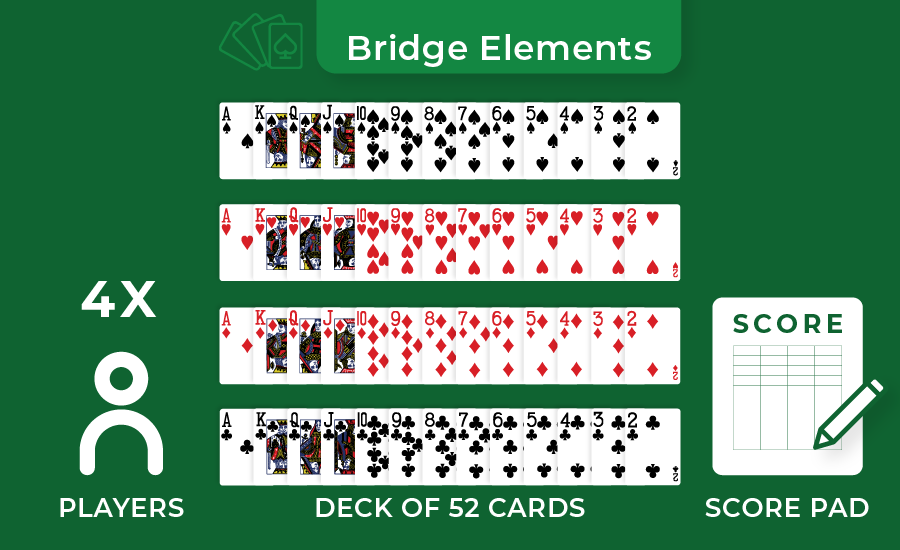
Bridge is a fun game that challenges your mind and requires teamwork.
Played with just a standard deck of 52 cards, you and your partner can score points by winning tricks with the highest-ranking cards in each suit.
Fun fact
Modern day bridge was invented less than a century ago in 1925, but it has it’s roots dating all the way back to the 16th century.
Previous incarnations were in the form of the game whist and it’s very similar to popular card games like hearts and spades, particularly spades.
But if hearts and spades are checkers then bridge would be chess.
Today, it is one of the most popular and competitive card games in the world, perhaps second only to poker variants.
Bridge can be played on many different levels. You can play casual bridge with a group of friends around the kitchen table, (we call it “kitchen bridge”).
You can play it more competitively at your local club or as we all have smart phones and computers these days, of course, online.
Recommendation
If after reading this guide you find the game interesting, you should go to bridgebase.com, the most popular site for bridge.
Or if you think you got what it takes to prove yourself, you can travel to nearby regionals or even national and international events to see how good you really are.
In general, bridge will appeal to people who like competitive games based on skill, not luck. If you like problem solving, math, and puzzles this is the game for you.
Bridge, like many other top games, can be frustrating to learn at first but it’s a game that gets better and better over time as you improve.
Bridge is not a good game for a casual pick up with a group of friends; it is best played by a group of dedicated players.
In terms of luck and skill, bridge falls somewhere between poker and chess, while both games are in the long run very much based on skill, those who have played those games understand the BIG difference in the short run.
Who is Bridge For?
If you want to play a game where the better player usually wins but you still have a chance against much better opponents, bridge is for you.
The reason duplicate bridge has relatively low luck for a card game is because your results are compared to others who have been dealt the exact same cards at other tables. So, it’s not what cards you’re dealt, but how well you use them, as everyone has the same cards at the other table(s).
Enough with the introduction, let's go over how the game is played. I will assume you have played some card games in the past.
Bridge is a 4 player game played with a standard 52 card deck. Each of the 4 players is randomly dealt 13 cards.
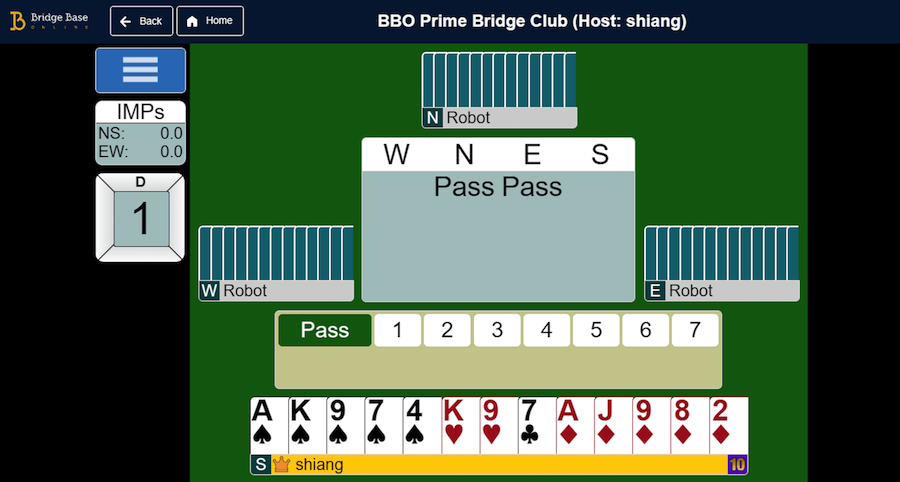
One of the most interesting things about bridge is it’s not a free for all. The players have a partner who sits across from them and opponents who sit to their left and right (think of a square table).
The 4 directions are North, South, East, and West. North and South are partners who work together, likewise East and West are partners.
The goal of the game is to get the best score possible on every hand. Easy right?
Bridge has 2 phases to the game:
- Bidding;
- Cardplay.
In the bidding phase you and your partners try to communicate what cards you each hold or try to obstruct the opponents from proper communication and reach the best scoring contract (guessing how many tricks you can take with a certain suit as TRUMP).
Believe it or not, top players can sometimes communicate almost every important card they hold through bidding.
In the card play phase you will then have to play out the cards and try to take as many tricks as you can.
If you take more tricks than what you’ve bid you get a positive score, if you take less tricks than what you bid you go down and get a negative score.
You always get the opposite of what your opponents score so if NS scores say 420 then EW scores -420.
I will explain the 2 phases in detail below.
Even though the bidding phase happens first I will describe the card play phase to you first, as good card play is by far more important to learn than fancy bidding. It’s impossible to be a good bidder without mastering card play as during the bidding you have to think about how the cards will play out.
There are 4 suits in bridge Spades, Hearts, Diamonds, and Clubs. There are 52 cards, so how many cards are in each suit? 52/4 = 13. The rank of the cards are as follows:
AKQJ1098765432, Ace being the highest and 2 being the lowest.
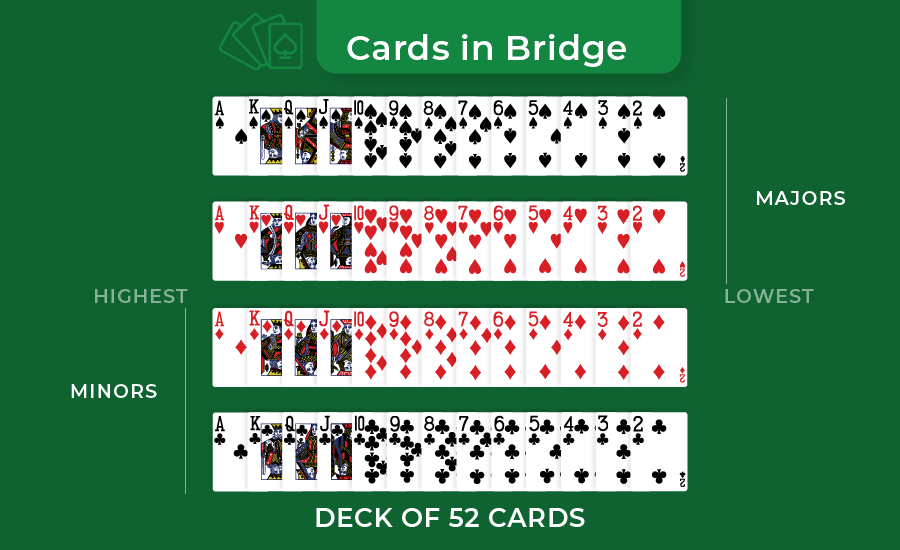
The 4 suits are not created equal, spades is the highest, then hearts, then diamonds, then clubs.
The Spades and Hearts are called Majors, the Diamonds and Clubs are called the minors.
The rank of the suit doesn’t matter during the play but it does matter when it comes to bidding and scoring. Which I’ll go over later in the article.
For now just know the Majors tend to be more important in the bidding, playing a contract with Major as Trumps scores better than with a Minor as Trumps.
Majors are worth 30 points per trick over 6 tricks, and Minors are 20 points per trick over 6 tricks.
In the special case where there is NO TRUMP you get 40 pts for the first trick over 6 tricks, and 30 pts for every subsequent trick above that, so it’s like a Major, but you get a 10 pt bonus on top.
Bridge Tricks and Trump Cards
A trick in bridge is where all 4 players produce a single card in a clockwise order, the player who produces the highest card in the suit led (played first) will win the trick UNLESS there’s a card in the TRUMP suit, if there is/are trump card(s) then the highest ranking trump wins the trick.
The suit that will be trump is determined during the bidding phase. There is at most 1 suit that’s trump or sometimes none of the suits are trumps also known as No Trump.
The person who wins the trick will then be the first to play the next trick, also known as the lead.
You must “follow suit” if possible. So if a Spade is lead (first card played on a trick) everyone MUST play a spade if they have one, if you have no more spades left then you can play whatever card you like, including trumps
Bridge Tricks and Trumps Examples
If the 4 of spades is lead (first card play to a trick), then everyone must play a spade if they have one.
Let’s say the 4 cards played are 4 of spades, 7 of spades, 9 of spades, and the A of hearts (because the last player ran out of spades).
Assuming hearts is NOT Trump, the 3d player who played the 9 of spades wins the trick as it’s the highest card in the suit lead and there are no trump cards.
Because East won the trick he will be on lead for the next trick.

Now let’s say instead we lead the 10 of hearts, then the other players play the J of hearts, the A of hearts, and the last player plays the 2 of spades.
This time let’s say spades IS the trump suit, even though the final player played only a 2 it’s trump so it wins the trick as trump cards beat non trump cards.
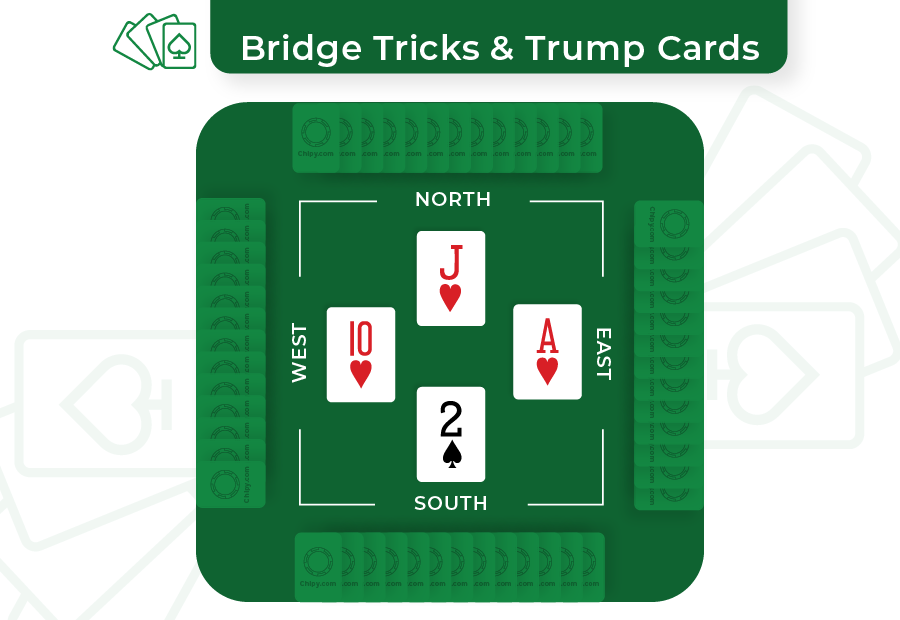
Here's one final example:
Lead is A of diamonds, 2nd player plays the 8 of diamonds, 3rd player plays 4 of hearts, final player plays the 10 of hearts. If hearts are trump then the final player wins the trick with the 10 of hearts as it’s the highest trump card.
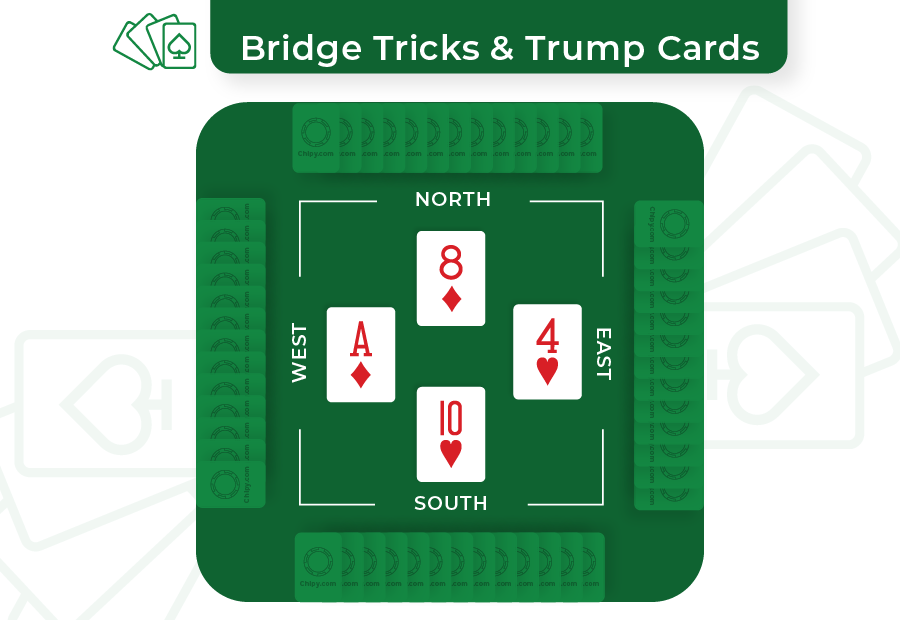
What Happens After All 13 Tricks Are Played
Once all 13 tricks have been played you count how many tricks each side took during the play.
Once a trick is completed, everyone takes the card they played on that trick back and places it on their side of the table face down, vertically if their side won the trick, horizontally if their side lost the trick.
Each trick is then placed in the order they were played, from left to right.
By the time a hand is completed, every player should have the 13 cards they started with in front of them, face down, on their side of the table, all turned vertically or horizontally.
All 4 players should have each of their 13 tricks turned the same way as the other 3 players, that way if there’s a discrepancy you can turn over the cards on a given trick and see who turned it incorrectly.
Pro tip
For learning card play I think the best resource is on BBO (Bridge Base Online, bridgebase.com). After you log in click on “practice”, then click on “bridge masters”. You will be given different card play problems from novice to world class.
The first stage of bridge is the bidding. You can learn more about it from my complete bridge bidding guide.
The person who dealt the cards will be the first to bid. After each hand, the dealer rotates clockwise.
For casual games between friends you can bid verbally, for example “one club”.
Here's an example of how a bid would normally look in bridge:

For competitive games, there is something called a bidding box, like the one in the image shown below.
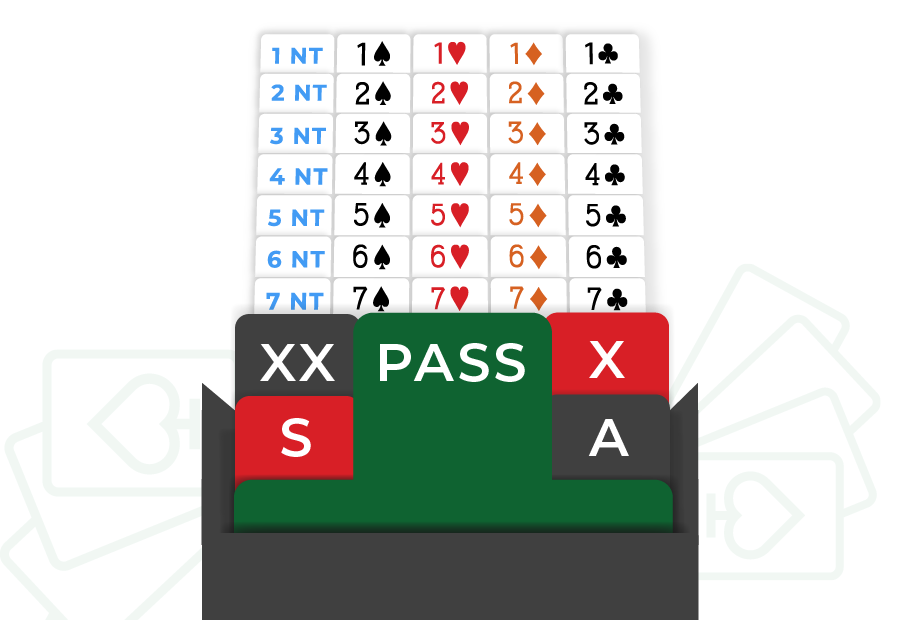
Once the dealer makes a bid, each player then takes turns making their bid in a clockwise order.
If all 4 players pass at the start, the hand is “passed out” and the score is 0. (This usually happens when all 4 players have balanced hands with 10 HCP and is rather rare)
After that, once a bid has been made if there are 3 passes in a row then the auction is over and the pair that made the last bid wins the auction and will try to make the contract.
The normal bids are pass, or you can bid a number and a suit. For example 1 club, 2 diamonds, 3 NO Trumps (NT).
The number indicates how many tricks you intend to take over average (6).
So if you bid 1 you’re trying to take 7(6+1) of the 13 tricks, if you bid 2 you try to win 8(6+2) tricks, if you bid 3 you try to win 9(6+3) tricks, and so forth up to 7(6+7) where you try to take all 13 tricks. Another way to think of it is the number of tricks over 6 you intend to take.
For example 5NT is 6+5 or 11 tricks.
Suit order is ranked, from highest to lowest:
- No Trump (NT);
- Spades (s);
- Hearts (h);
- Diamonds (d);
- Clubs (c)
Level takes precedence over the rank of the suit
So for example 1nt is higher than 1s, but lower than 2c. Even though clubs is a lower rank suit than no trump, 2c is at the two level, so it’s higher than 1 no trump.
If I were to list out the order from lowest to highest bid it would go: 1c, 1d, 1h, 1s, 1nt, 2c, 2d, 2h, 2s, 2nt, 3c, 3d, 3h, 3s, 3nt, 4c, 4d, 4h, 4s, 4nt, 5c, 5d, 5h, 5s, 5nt, 6c, 6d, 6h, 6s, 6nt, 7c, 7d, 7h, 7s, 7nt.
You can only bid higher and higher, you cannot bid equal or lower.
So if, for example, partner’s last bid is 3d, the next opponent passes, you can only pass or bid 3h or higher but not 3d or lower.
Double and Redouble
There are 2 other bids used during the bidding called the double (x), and redouble (xx), which significantly raises the stakes of the contract if it ends up being played. You score more for making your contract (taking equal or more tricks than the level you bid + 6), you go negative more for going down (taking less tricks than the level you bid + 6).
- You can only double if your opponents are the last ones to make a bid (1c - 7nt), you can not double your partner’s bids.
- You can only re-double your opponents doubles, there’s no other case where re-double can be made.
For example
If my partner bids 1h, right hand opponent (RHO/righty) passes, I can not double my partner’s 1h. But if righty opens 1h I can double his 1h as he’s my opponent. If say RHO opens 1h and I double, LHO (left hand opponent/lefty) can re-double my double, but if LHO passes my partner can’t re-double my double he can only pass or make a higher bid.
Let’s take a look at a simple auction below:

I’m sitting South with 3 robots, East was the dealer and was the first to bid. Generally you should pass with average and below average hands and bid with above average hands, I won’t go into detail about what to bid in this article, only how bidding works.
Looking at the auction box - East deals and was the first to bid and passes saying he has an average or below hand.
I pass as south with only 5 HCP and a bad hand. ( HCP = High card point, it’s like training wheels for beginners, they roughly estimate the quality of your hand).
An A = 4, K = 3, Q = 2, J = 1.
So since there’s 4 suits and each suit has A+K+Q+J = 10, there’s always 40 total HCP. On average you’ll have about 10.
Recommended Opening Bid
For beginners I recommend making an opening bid if you have 12 or more High Card Points, for intermediate+ I recommend most 11’s.
Now the opening bid ONLY applies to the very first bid that’s NOT a pass, do not confuse that with bids past the very first bid.
Lefty(W) now bids 1s, showing 5 or more spades and 11+ pts (technically since he’s in 3rd seat (3rd person to bid) he’s allowed to bid with quite a bit less and a good spade suit but I won’t get into why here). So W is now the opener, as he’s the first one to bid something other than pass.
Partner makes a double(x), in bridge, players have learned it’s much better to use a low level double as what’s called a takeout double.
He is not saying he really likes spades, in fact, it’s the opposite.
He’s saying he does NOT like spades, usually 2 or less, has a decent hand, but doesn’t not know which suit to bid, usually he has at least 3 cards in all the unbid suits, and wants me to pick the best suit (other than spades).
Righty(E) now bids 2s, showing he’s got 3 or more spades and a couple of pts (about 4-10)
Now it’s my turn again, what should I bid given the information so far? My hand is WELL below average on HCP, only 5 when on average there’s 10.
But before automatically reaching for the pass card lets do some thinking - How many spades do they have?
Lefty/LHO has at least 5, righty/RHO has at least 3, I have 4.
There’s only 13 spades so 5+3+4 = 12 so partner has either a singleton(1) or a void(0) in spades.
I also have 5 clubs and my partner should have at least 3, and often times 4, so we have 8 or more clubs.
If I think about the play of the hand I realize I can use my partner’s clubs to ruff my little spades and while I don’t have many HCP I do have a long club suit and hence not many tricks to lose in the red suits (H+D).
So despite having very few HCP I decide to bid 3c, even if it goes down one it’s not so bad because they probably make 2s if we can’t even make 3c with a supper good fit.
Lefty now bids 3h, he’s not trying to play in hearts as they’ve already found a good 8+ card spade fit, he’s saying he’s got better than a minimum opener, about 16 or more pts in total strength with some good cards in hearts and is inviting his partner to bid a game in spades (4s).
Please note
3s instead of 3h would be just competitive saying he just wants to play in 3s with some extra shape but thinks game in 4s is unlikely.
Partner passes. Righty accepts the invite and bids 4s, and that’s pretty much everyone had to say and after all 3 of the other players pass 4s is now the contract.
So 4s is the final bid that means E/W are declaring and we, N/S, are defending.
Winning the Auction
In bridge, the side that wins the auction has only 1 person that plays the cards for BOTH players on their team.
His hand will be hidden while his partner’s hand will come down on the table for everyone to see AFTER a card is led.
The person playing the cards for the side that won the auction is the declarer, the person with his cards on the table and has his cards played for him by his partner, is the dummy.
The dummy will just sit there and looks pretty, he’s not allowed to do anything other than turn the cards on who won and who lost the trick, trying to help anyone would be considered blatant cheating.
The first person to bid the suit that won the auction will be the declarer and his partner will be the dummy.
So in the above picture, E is the one that made the final bid of 4s, but it is W who first bid spades for their side.
So who’s the declarer?
It is W as he’s the first to bid spades with 1s. Card play goes clockwise like bidding, the declarer always plays last on the first trick so my partner is the one that leads and he led the Q of hearts.
Now because their final contract is 4s they need to try to take 6+4 = 10 tricks and we as defenders try to prevent that by taking 4 tricks. Our score will be compared to the score of other tables bidding and playing the exact same hand.
Important Bridge Bidding Terminology
- Opener - The first person to make a bid other than a pass
- Responder - The partner of the Opener
- Overcaller - The first opponent of the opener who bids other than pass
- Advancer - The partner of the overcaller
Remember
Bidding is a game of communication so the optimal ways to bid is to be able to communicate what you have without going over the contract you can make during the play as you generally don’t want to go down, getting a negative score.
There are exceptions.
As I've mentioned earlier, sometimes it’s good to not make your contract and get a negative score. That’s called a sacrifice.
The opponents might score more if you let them play in their contract. At the end of the day it’s the score that matters not if you make your contract.
Bids aren’t always natural (showing the suits that are actually bid), it’s more efficient to use a coded system where each bid is assigned a meaning to maximize the usage of all the bidding space available.
For the math oriented, they’ll understand the concept of permutations, or the number of possible combinations of bids, the more permutations your bidding system can allow the more hands you can show to your partner.
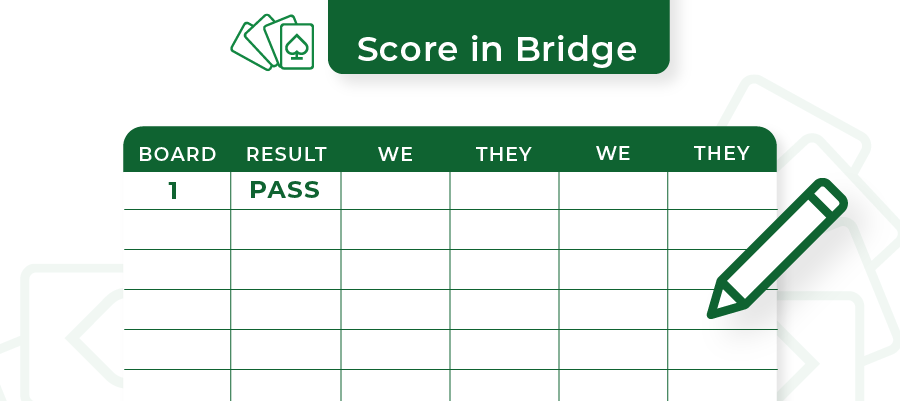
Score is the most important in bridge. You’ll need to know how to score, though it is probably the LEAST important thing to learn today.
Don’t worry too much about it, it will be done automatically online and the scores will be on the back of the cards in the bidding box.
But for advanced players they’ll have to consider the final score when deciding on a bid or how to play cards. For everyone else this is just some info if you’re interested, don’t worry if you don’t remember it all.
Remember
The majors are spades and hearts, the minors are diamonds and clubs, then there is no trump.
For minors it’s 20 pts for each trick over 6, for majors it’s 30 pts, for NT it’s 40 for the first and 30 for each subsequent trick.
It is always good to take as many tricks as you can during the play.
For example
- If you bid 1nt but win 8 tricks you get a base score of 40+30 = 70
- If you BID AND MAKE a contract worth 100 pts or more you get a big bonus called a game bonus. So you need to bid 5 for minors (5x20), 4 for majors (4x30), and 3nt (40+2x30) and make the contract to get the game bonus.
- When you bid and make 6 you instead get a slam bonus
- When you bid and make 7 you instead get a grand slam bonus.
- If you bid less than a game you get a partscore bonus.
Vulnerability
Another aspect of bridge scoring is something called vulnerability, when the pair that wins an auction is vulnerable they get a bigger bonus for bidding and making games and slams, they lose more pts when they go down.
The vulnerability goes in a cycle of 16, with 4 sections, think of it as stanzas to a poem.
The cycle for the first 4 boards is:
- None vulnerable;
- N/S vulnerable;
- E/W vulnerable;
- Both vulnerable.
The next 4 you just shift it to the left, so board 5-8 is
- N/S vulnerable;
- E/W vulnerable;
- Both vulnerable;
- None Vulnerable
For 9-12, the cycle will be:
- E/W vulnerable;
- Both vulnerable;
- None Vulnerable;
- N/S vulnerable.
For 13-16, the cycle will be;
- Both vulnerable;
- None Vulnerable;
- N/S vulnerable;
- E/W vulnerable.
Please note
The pattern is:
a = no one vul, b = N/S vul, c = E/W vul, d = both vul
Not vulnerable is also known as white, vulnerable is known as red.
So when you’re making a sacrifice keep in mind the vulnerability. It’s better to sac when you’re white on red (you’re white they’re red) than if you’re red on white.
The reason for this added complexity is to try to give each player a chance to play hands in different seats (1st, 2nd, 3rd, last to bid) and with different vulnerabilities in each of those seats (white on white, red on white, white on red, and red on red)
Going Down
The scoring for going down is easiest so lets start there.
Not doubled:
- 50 for each trick short of your contract not vulnerable/white;
- 100 for each trick short of your contract vulnerable/red.
Doubled:
- White: -100, -300, -500, -800, -1100, -1400 ect, pattern is 100 for the first, 200 for the next 2, then 300 for every subsequent one
- Red: -200, -500 -800, -1100, -1400 ect, pattern is 200 for the first, 300 for every subsequent
Redoubled is just double the score of doubled for going down:
- White: -200, -600, - 1000, -1600, - 2200, ect
- Red: -400, -1000, -1600, -2200 ect
Key takeways
Red re-doubled down 13 is the highest score possible. That’s 400 for the first trick and 600 for the next 12 so 400 + 600x12 = 7600
The slang for 4 digit scores in bridge is “telephone numbers”. You don’t want to give those away when it’s self-inflicted.
Making the Contract/Overtricks
No doubles:
For contracts below game you get your base score plus a partscore bonus of 50
Let’s say you bid 2c and make 10 tricks. You get 20x4 (you played for 4 tricks over 6) + 50 = 130
Or if you bid 2nt and make 10 tricks, you’ve made 4nt but didn’t bid it so you get 40 for the first then 30 each for the next 3 and your partscore bonus of 50 so 40+30x3+50 = 180
If you bid and make a game you get a bonus of 300 for white games, 500 for red games plus your base score from the tricks you take but no partscore bonus.
So lets say you bid and make 4s white, that’s 4x30 + 300 = 420, red it would be 4x30 + 500 = 620
If you bid 3nt and make 5nt white, that’s 40+ 30x4 + 300 = 460, red it would be 40+ 30x4 + 500 = 660
Slam bonus white is 500, red is 750. Grand slam bonus white is 1000, red is 1500
This is ON TOP of your game bonus so total bonus is really:
Slam bonus white is 800, red is 1250. Grand slam bonus white is 1300, red is 2000
Lets say you bid 6nt and make 7 white you would get 800 bonus + (40+30x6) tricks = 1020, red you would get 1250 bonus + (40+30x6) tricks = 1470
Doubled and Redoubled Making and Over Tricks
If doubling doubles the base score, re-doubling doubles that again.
If the base score of the contract you BID, doubled is now over 100 you get your game bonus, same goes for redoubled.
This only applies to the game bonus, NOT the slam bonus.
For example
If you bid 2h and it gets doubled that’s 2x(2x30) = 120 so you get your game bonus, if you bid 2c and it gets doubled thats’ 2x(2x20) = 80 so there’s no game bonus, if you bid 2d and it gets redoubled thats 2x(2x(2x20) = 160 so that is a game
1c re-double is not a game because that's 2x2x20 = 80.
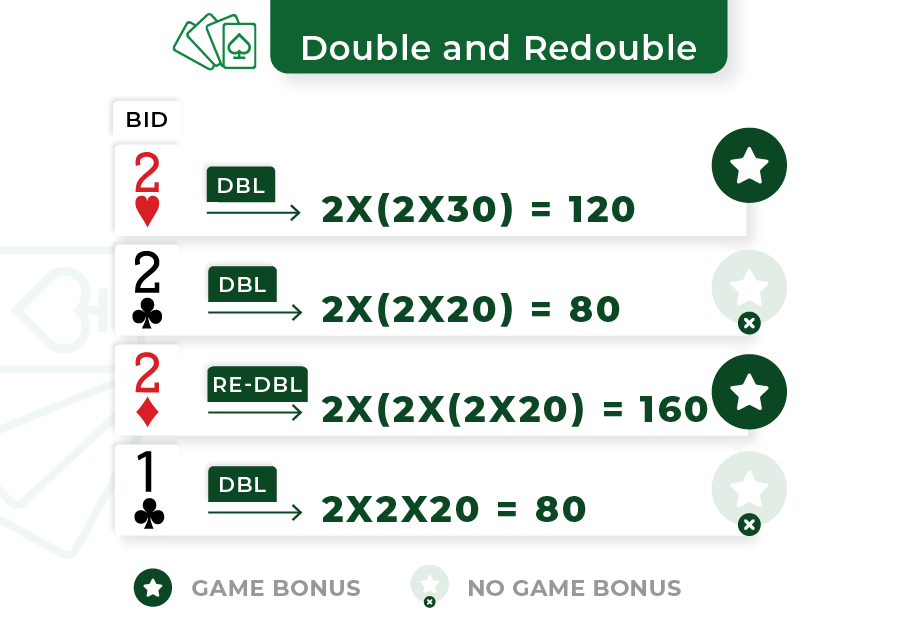
Doubled and redoubled contracts with overtricks are the most confusing to score.
The simple way to think about it is to split it into 3 parts:
- The contract bid and made
- The over tricks
- The Insult bonus (they’ve insulted you by saying you won’t make it)
The contract made is pretty simple: it's the base score of whatever you bid x2 for doubles, x4 for re-double.
The over tricks are scored separately 100,200,400. 100 for doubled white, 200 for doubled red or redoubled white, 400 for redoubled red for EACH overtrick.
Slam and game bonuses are added as normal. +50 pt insult for doubled contracts made, +100 for re-doubled contracts made.
For example
Let’s say the contract is 2c re-double, and you actually take 10 tricks and you’re vulnerable. So first let’s look at the base contract bid of 2c re-double, that’s 4x(2x20) = 160. So you get that 160 pts and since it’s over 100 for 4 times the base contract worth 40 you get your vulnerable game bonus of 500.
So you have 160 for your bid contract tricks + 500 game bonus.
Now let’s look at your overtricks. You made 10 tricks, you bid 2 so 6+2 = 8. So you made 2 overtricks beyond your contract bid during the play. Vulnerable re-double overtricks are worth 400 each and you scored 2 of them so that’s 2x400 = 800
Now we have 160 (from the contract tricks) + 500 game bonus + 800 (for the 2 over tricks) + 100 redoubled insult = 1560
The reason re-double 13 scores best is because you can only score 6 over tricks but can be down 13 :) as you have to bid at least 1.
Again remember you can only get the game bonus if your base score gets double or re-double above 100. You can NOT get the slam bonus, you must bid 6 or 7 to get that. The bonus themselves do NOT get doubled or re-doubled; they stay as 1x.

Bridge is a game of logic, you are ONLY allowed to deceive through the bids you make, and the cards you play.
You are NOT allowed to have hidden agreements with your partner, it’s your job to inform your opponents of all your agreements and general habits.
The opponents should know you as well as your partner and yourself. This is not optional, it’s mandatory, and part of the game.
You are NOT allowed to fake social expressions or take actions quicker or slower to intentionally fool your opponents.
If you do so and damage your opponents they are entitled to have a director fix the score to what would’ve been normal had you not conducted any infractions, and you may receive a penalty in either the score or a procedural penalty all the way up to being banned from all competitive games for open cheating (hidden signals, fixing cards, ect).
In bridge it is common and encouraged for you and your opponents to ask about the meanings of bids and cards played.
You are REQUIRED to tell them the meanings and inference/negative inferences of your bids and plays. However, you shouldn’t tell them the actual cards you hold, it’s their job to try to figure out what you have based on what you bid and played based on their meanings meanings.
It’s your job to keep them in the dark when it benefits you but only through your bids and card play, not through hiding the agreed meanings of your bids and plays or physical psychology.
This is known as full disclosure.
Key takeaway: win through logic, not through petty chicanery.
One of the key reasons for this is bridge is a partnership game, unlike poker, hence hidden agreements would completely destroy the game and make it literally unplayable and no fun at all.
Bridge is a “gentleman's” game, though you can be as cut throat as you want with the bids you make and the cards you play ;) (*with a few legal restrictions set by various bridge organizations depending on the jurisdiction you’re playing the game in*).
Final Thoughts
Congratulations! You've made it to the end of this guide on how to play bridge.
By now, you should have a good understanding of the basics of bridge, including bidding, playing the cards, and communicating with your partner.
Remember
Bridge is a game that requires practice and patience. It takes time to develop the skills necessary to become a skilled player. But with dedication and a willingness to learn, you can improve your strategy and teamwork.
Playing bridge can be a fun and rewarding experience. It's a game that challenges your intellect and can be enjoyed by people of all ages. So, whether you're a beginner just starting out or an experienced player looking to improve your skills, I encourage you to keep playing and learning more in the Bridge Academy.
Thank you for reading this guide, and I wish you the best of luck at the bridge table!

Bonuses
Casinos
Games
Academy
News
Shop
NEW Q&A
Sweepstakes
















